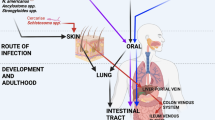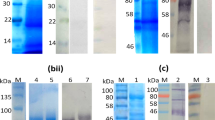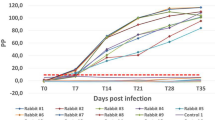Abstract
MAST cells are thought to have a major role in the host response to parasitic helminths. Infection with these organisms is often accompanied by anaphylactic hypersensitivity and mast cell infiltration1. In several experimental models, host resistance to helminth infection has been shown to be dramatically suppressed as a result of mast cell depletion1. For example, after injection with reserpine, laboratory mice are unable to mount a cutaneous inflammatory response against Schistosoma mansoni (A.S., P. W. Askenase, S. McIntyre and F. von Lichtenberg, unpublished) and after pretreatment with compound 48/80 can no longer immunologically reject challenge infections of this parasite2. Interactions between mast cells and helminths have generally been attributed to soluble antigens released into tissue fluids. Described here is a series of in vitro experiments with schistosomula of S. mansoni which demonstrates that mast cells are also capable of reacting directly with parasite surfaces. This interaction appears to depend on the recognition of parasite-bound complement by receptors on the mast-cell membrane.
This is a preview of subscription content, access via your institution
Access options
Subscribe to this journal
Receive 51 print issues and online access
$199.00 per year
only $3.90 per issue
Buy this article
- Purchase on Springer Link
- Instant access to full article PDF
Prices may be subject to local taxes which are calculated during checkout
Similar content being viewed by others
References
Ogilvie, B. M., in Progress in Immunology II, 4 (edit. by Brent, L. and Holborrow J.), 127–135 (North-Holland, Amsterdam, 1974).
Dean, D. A., Murrell, K. D., Minard, P., and Vannier, W. E., Fedn Proc., 35, 228 (abstr. No. 116) (1976).
Clegg, J. A., and Smithers, S. R., Int. J. Parasit., 2, 79–98 (1972).
Butterworth, A. E., Sturrock, R. F., Houba, V., and Rees, P. H., Nature, 252, 503–505 (1974).
Paterson, N. A., Leid, R. W., Said, J. S., Wasserman, S. I., and Austen, K. F., in Lung Cells in Disease (edit. by Bouhuys, A.), (North-Holland, Amsterdam, in the press).
Smithers, S. R., and Terry, R. J., Parisitology, 55, 695–700 (1965).
Mayer, M., in Experimental Immunochemistry (edit. by Kabat, E. A.), 2nd ed. (Thomas, Springfield, Illinois, 1961).
Cochrane, C. G., Müller-Eberhard, H. J., and Aiken, B. S., J. Immun., 105, 55–69 (1970).
Pillemer, L., et al., Science, 120, 279–285 (1954).
Götze, O., and Müller-Eberhard, H. J., J. exp. Med., 134, 905–1085 (1971).
Fine, D. P., Marney, S. R., Colley, D. G., Sergent, J. S., and Des Prez, R. M., J. Immun., 109, 807–809 (1972).
Machado, A. J., Gazzinelli, G., Pellegrino, J., and Dias da Silva, W., Expl Parasit., 38, 20–29 (1975).
Müller-Eberhard, H. J., and Vallota, E. H., in Biochemistry of the Acute Allergic Reactions (edit. by Austen, K. F. and Becker, E. L.), (Blackwell, Oxford, 1971).
Nelson, D. S., in Ciba Foundation Symposium on Complement (Churchill, London, 1965).
Lay, W. H., and Nuzzenzweig, V., J. exp. Med., 128, 991–1007 (1968).
Author information
Authors and Affiliations
Rights and permissions
About this article
Cite this article
SHER, A. Complement-dependent adherence of mast cells to schistosomula. Nature 263, 334–336 (1976). https://doi.org/10.1038/263334a0
Received:
Accepted:
Issue Date:
DOI: https://doi.org/10.1038/263334a0
This article is cited by
-
Action of diethylcarbamazine citrate on protective immunity in rats infected withNippostrongylus brasiliensis
Zeitschrift f�r Parasitenkunde Parasitology Research (1985)
-
Enzyme mediators of mast cells and basophils
Clinical Reviews in Allergy (1983)
Comments
By submitting a comment you agree to abide by our Terms and Community Guidelines. If you find something abusive or that does not comply with our terms or guidelines please flag it as inappropriate.



